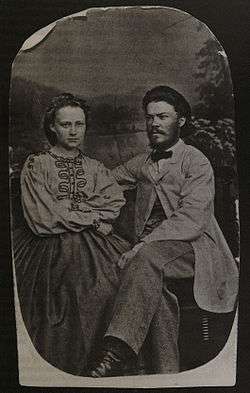Minna Canth
| Minna Canth | |
|---|---|
 Portrait of Minna Canth by Kaarlo Vuori | |
| Born |
19 March 1844 Tampere, Finland |
| Died |
12 May 1897 (aged 53) Kuopio, Finland |
| Occupation | writer |
| Spouse(s) | Johan Ferdinand Canth (1835–1879) |
| Parent(s) |
Gustaf Vilhelm Johnsson Lovisa Ulrika Archelin |
Minna Canth (IPA [minna ka:nt], born Ulrika Wilhelmina Johnsson, 19 March 1844 – 12 May 1897) was a Finnish writer and social activist. Canth began to write while managing her family draper's shop and living as a widow raising seven children. Her work addresses issues of women's rights, particularly in the context of a prevailing culture she considered antithetical to permitting expression and realization of women's aspirations. Her play The Pastor's Family is her best known. In her time, she became a controversial figure, due to the asynchrony between her ideas and those of her time, and in part due to her strong advocacy for her point of view.
Minna Canth is the first woman to receive her own flag day in Finland, starting on 19 March 2007. It is also the day of social equality in Finland.
Life and career
Canth was born in Tampere to Gustaf Vilhelm Johnsson (1816-1877) and his wife Ulrika (1811-1893). His father worked at James Finlayson's textile factory initially as a worker and later as a foreman. Gustaf and Ulrika had four children, Minna included, of whom the eldest, Adolf, died in infancy. Minna's surviving siblings were Gustaf (1850-1894) and Augusta (1852-1877). In 1853 his father was given charge of Finlayson's textile shop in Kuopio and the entire family relocated there.[1]
Canth received an exceptionally thorough education for a working class woman of her time. Even before moving to Kuopio she had attended school at Finlayson's factory which was intended for the workers' children. In Kuopio she continued to go to various girls' schools and as a testament to her father's success as a shopkeeper, she was even admitted into a school intended for upper class children. In 1863 she began her studies at the recently founded Jyväskylä Teacher Seminary, which was the first school in Finland to offer higher education for women.[2]
In 1865 she married her natural sciences teacher, Johan Ferdinand Canth, and had to drop out of the Seminary. Between 1866 and 1880 she gave birth to seven children and began her writing career at the newspaper Keski-Suomi, where her husband worked as an editor. She wrote about women's issues and advocated temperance. In 1876 the Canths were forced to leave the paper because Minna's writings had roused some bad blood; they were, however, both employed by the competing Päijänne the following year. Minna published her first works of fiction on the pages of Päijänne: various short stories, which were compiled in her first book, Novelleja ja kertomuksia, in 1878.[3][4]
Debate
Canth stood out when there was public debate about women's rights. In 1885 a Bishop had argued that God's order required that women were not emancipated. The writer Gustaf af Geijerstam then argued that men could only aspire to one day have the purity of women because they were fundamentally different and this was the reason for prostitution and other immorality, Canth objected strongly to this argument as it meant that men could defend their poor morals by reference to their implicit shortcomings, whereas any women involved in prostitution would lack the same defence.[5]
Most important works

Minna Canth's most important works are the plays Työmiehen vaimo (The Worker's Wife) from 1885 and Anna Liisa, penned in 1895.
In Työmiehen vaimo, the main character Johanna is married to Risto, an alcoholic who wastes all his wife's money. Johanna cannot prevent him – her money is legally his, not hers. The play's premiere caused scandal, but a few months later, parliament enacted a new law about separation of property.
Anna Liisa is a tragedy about a fifteen-year-old girl who gets pregnant without being married – she manages to hide her pregnancy, and when the child is born, she suffocates it in a fit of panic. Her boyfriend Mikko's mother helps her – she buries the baby in the woods, but a few years later, when Anna Liisa wants to marry her fiancé Johannes, she is blackmailed by Mikko and his mother. They threaten her to reveal her dark secret if she does not agree to marry Mikko, but Anna Liisa refuses. In the end, she decides to confess what she has done. She is taken to prison, but is much relieved after owning up and seems to have found peace.
Translations
Canth, Minna: The Burglary and The House of Roinila. Translated into English by Richard Impola. Aspasia Books, Beaverton 2010.
Further reading
Sirkka Sinkkonen, editor (1986) Toward equality: proceedings of the American and Finnish Workshop on Minna Canth, Kuopio, 19 to 20 June 1985. University of Kuopio. ISBN 951-780-823-2.
References
- ↑ Vuorikari, Outi. ""Myrskylintu Tampereelta"". Minna Canth. Kuopio Museum of Cultural History. Retrieved 30 March 2017.
- ↑ Vuorikari, Outi. "Kauppiaan tyttären koulut". Minna Canth. Kuopio Museum of Cultural History. Retrieved 30 March 2017.
- ↑ Maijala, Minna. "Minna Canth (1844-1897)". Klassikkogalleria. Kristiina Institute, University of Helsinki. Retrieved 31 March 2017.
- ↑ Vuorikari, Outi. "Minna Canthin monet roolit Jyväskylässä". Minna Canth. Kuopio Museum of Cultural History. Retrieved 31 March 2017.
- ↑ Jaakko Ahokas (1973). A History of Finnish Literature. Taylor & Francis. p. 113. ISBN 978-0-87750-172-5.
External links
| Wikimedia Commons has media related to Minna Canth. |